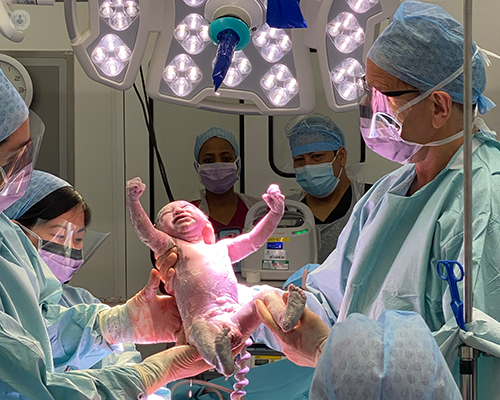Emergency caesareans: how painful and safe are they? FAQs answered by a specialist
Written in association with:During pregnancy, it’s not uncommon for expectant mothers to worry about the possibility of an emergency caesarean (also known as C-sections). In this article, Mr Christian Barnick, a leading consultant in obstetrics and gynaecology, provides you with a thorough understanding of emergency caesareans.

What is an emergency caesarean section?
Altogether there are four categories of caesarean section (also called C-section), and categories 1 to 3 are all classed as emergencies while category 4 is not. The category depends on how urgent the caesarean is.
- In a category 1 caesarean section, we would expect the caesarean section to be carried out within thirty minutes. In fact, in most of these situations, we really want to perform the caesarean section within about 15 minutes. This is due to the baby being severely distressed, the fact that we are concerned about the mother or a combination of both.
- Category 2 caesarean sections can be carried out between 30-60 minutes of the decision as it is not deemed particularly urgent.
- Category 3 caesarean sections are non-urgent and carried out at a time that has not been previously organised, so in a sense, they are still classed as an emergency.
- Category 4 is a planned caesarean that happens at a pre-organised time. There is no urgency.
What are the common reasons to have one?
The two most common reasons for having an emergency caesarean section are failure to progress in labour or because of foetal distress. In many cases, it’s a combination of these two factors as the baby becomes increasingly distressed as the labour becomes longer.
Both of these indications are slightly ‘soft’ as it is not absolutely clear what slow labour is or exactly what foetal distress is; different people will have different interpretations of the criteria that are put in place. Some obstetricians will opt for a caesarean quite early and others are prepared to wait longer providing that the mother and baby show no signs of distress or exhaustion. There are many other reasons for an emergency caesarean section such as bleeding or infection or problems with the mother, but the list is far too long to list individually.
How long can it take? Are women always awake?
How long it takes before caesarean sections are performed depends on the emergency of the caesarean. The caesarean itself is usually carried out under a spinal anaesthetic and it is only very rarely that we need to fully anaesthetise a woman for her caesarean. This is really only in extreme situations. We try to have women awake during the caesarean as much as possible as it is also safer for mother and baby.

Are emergency caesarean sections more painful and less safe than planned ones?
Emergency caesarean sections are not more painful than planned ones because the same analgesia (pain relief) is used. This pain relief can be applied by performing either a spinal or an epidural anaesthetic. Women are always given painkillers following the procedure and we would not expect women to have any more pain in emergency C-sections versus routine situations.
The safety of an operation can be broken up into different aspects. First, there is the safety of the anaesthetic which of course is similar in both procedures. Also, we might then look at the safety of the immediate operation. In emergency C-sections, there is normally more blood loss, a greater risk of infection and deep vein thrombosis as well as a greater risk of damage to the womb or bladder during the procedure. This is because the labour has become more advanced, resulting in the womb being stretched more and the head potentially deeply engaged in the pelvis. As such, emergency caesarean sections are less safe than planned ones.
However, we would expect the recovery to be similar, although women having emergency caesarean sections are inevitably going to be more tired and more stressed for the first few days following the operation. Emergency caesarean sections are not always as urgent as they sound. As I mentioned earlier, there are different categories and many women will fall into category 2 or 3. There is always plenty of time to sort our proper analgesia. We are always cautious about giving women antibiotics, making sure that we give drugs to stop excessive bleeding and are mindful of the risks of the surgery itself.
Mr Barnick has over 30 years’ experience assisting women with their caesareans among many other aspects of obstetrics and gynaecology. Visit his profile to learn how he can help you.


